Slip Sliding Away…From Par
Lots of golfers take pride in being a “dew sweeper.” As one of those golfers, I can attest that very little beats the feeling of being the first one on the course. You set the pace, it’s quiet…what more could you want?
But is that dew spoiling your approach shots? Can a heavy rain soak your chances for a good score? For this edition of Golf Myths Unplugged, we tested how water affects approach shots, and the results left us scratching our heads.
The Myths
Myth #1 – A wet club face will reduce spin on wedge shots
Myth #2 – A wet club face will reduce spin on iron shots
Myth #3 – A wet club face will reduce accuracy
Myth #4 – A wet club face will make shots less consistent
How We Tested
For this test, we brought together six golfers with handicaps ranging from scratch to ten. Each player hit four series of five shots: wet and dry wedge shots and wet and dry 6I shots. The same 6I and wedge were used for every player. Each player hit their shots in a different order so as not to bias for or against any condition. For the wet shots, the club face was sprayed with water immediately before the shot was struck. Every shot was measured by Trackman. All testing was done at Club Champion.
The Results
We’ve all heard about flyers – shots that don’t have their normal spin and soar beyond their expected yardage. That’s what we expected to see when we soaked the club face in water before each shot…but it’s not.
All six of our testers produced more wedge spin with the wet club face than with the dry club face. In some cases the difference was marginal – a couple hundred RPM on shots spinning at 8,000 or 9,000 RPM. However, two of our testers saw increases of over 1,000 RPM.
This runs so contrary to our experience and intuition that we were hesitant to break out the “Busted” graphic, but the data is clear. That said, we have some further thoughts which we’ll get into at the end.
We reached the same conclusion about the 6I as the wedge – the wet club face actually added spin – but the data was even stronger. We had one player add almost 2,000 RPM and the smallest gap was 500 RPM. The most common gap was a full 1,000 RPM.
Knowing that our wet shots spun more than dry ones, we expected that the accuracy would be at least equal. For once, we were right. Among our six players, no one was significantly more accurate with the wet or dry shots.
This held true for wedge shots and 6I shots. Our testers were equally divided. Some were slightly better with a dry face, some slightly better with a wet face. Also, several testers were better in different conditions for different clubs – i.e. they were more accurate with a dry 6I but a wet wedge.
To evaluate this myth, we looked at numerous pieces of data – spin, launch angle, distance, and landing angle. We were focused on the ranges produced within each set of shots. We found that in roughly 60% of the cases, the the wet club face produced a larger range of outcomes.
Looking at spin, we saw four of our players generate wider ranges with the wet club face. For example, a player was between 4,200 and 5,000 RPM with a dry face, but 5,200 and 6,400 with a wet face. Differences like that translate to larger gaps in carry and total distance.
What should be emphasized is that the biggest consistency killer was switching between wet and dry club faces, particularly with the 6I. Our players saw carry distance gaps as large as 15 yards because of differences in launch and spin.
The Takeaway
There have been outcomes in the past that surprised us, but this left us completely confused. It also leaves us hungry to do more testing. One place to start would be with a different launch monitor. Would a camera-based system like Foresight produce different numbers? That’s something we plan to find out. It’s also possible that flyers have more to do with the interference of grass and debris than water. This would be a tougher test – indoors or out – but it’s worth exploring.
What do you think? Do you have a hypothesis or another question for us to test?
Let us know in the comments section.
He founded Plugged In Golf in 2013 with the goal of helping all golfers play better and enjoy the game more.
Matt lives in the northwest suburbs of Chicago with his wife and two daughters.
- Performance Golf Click Stick Training Aid Review - October 18, 2024
- Callaway Opus Platinum Wedge Review - October 17, 2024
- When to Take a Break from Golf - October 15, 2024



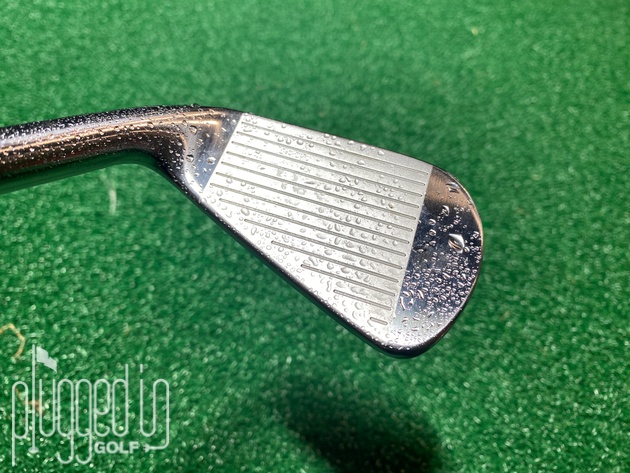

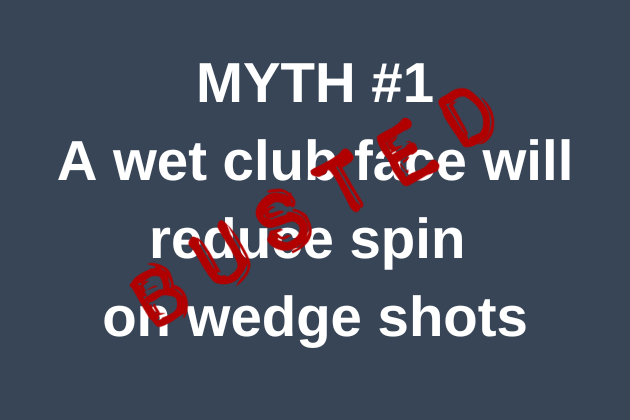
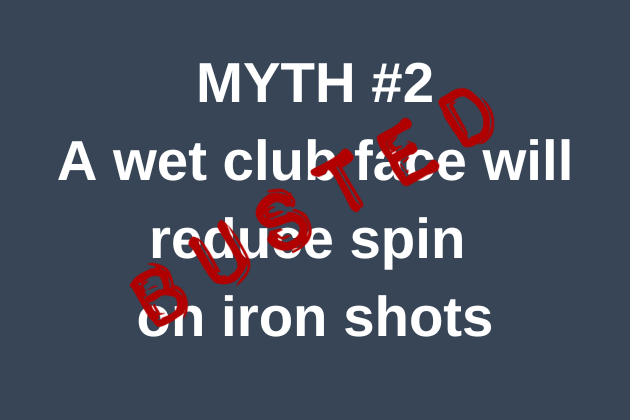
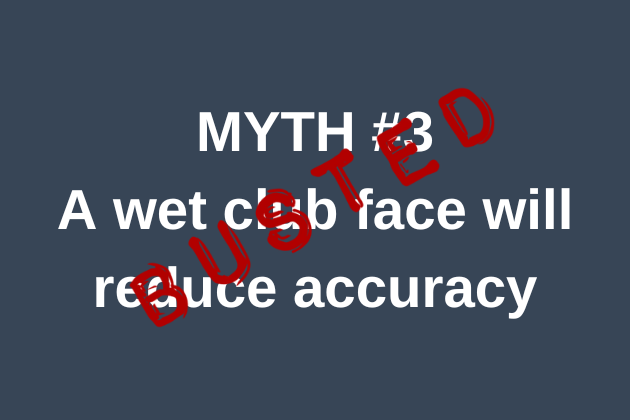
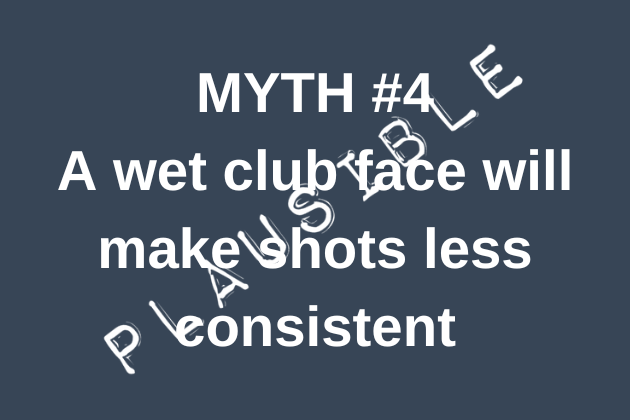












20 Comments
Always enjoy the test PIG performs. But I can’t help but think that a dry iron that ideally strikes a golf ball first is not affected by wet conditions unless wet grass (depending on length) and the resulting moisture is trapped in that brief interaction, creating a lower COF.
It’s been my experience that it creates unpredictable results on the golf course.
I hope you will have an opportunity test under playing conditions. Thanks for all you do.
MGS did their test with the moisture on the ball and mat to test wet conditions effects on ball spin. I’d be hesitant about applying water to the face because during the swing the air resistance could push the water off the face or towards the grooves.
James,
We may look at spraying the ball for a future test. I can see the water on the face moving during the swing, but my intuition is that the swing wouldn’t remove all the water.
Best,
Matt
I’m confused as to whether it was your dry six iron or wet six iron that went further. I’m assuming the dry six iron went further because of the extra spin on the wet six iron, but it’s unclear to me.
Steve,
The wet six iron spun more and lost distance.
-Matt
Thank you Matt for an interesting article. I am able to play about 200 rounds a year, starting before the Sun is up. Our group is called the Dew Sweepers. I never dry off my club or ball, just make sure they are debris-free. No one I know who plays early drys off anything. And I’ve not heard a complaint about mis-hits due to moisture. Cheers! Ray Weber in California
Isn’t it possible that the reason we get less bite on wedge shots has less to do with the spin but more due to the condition of the green? I imagine a ball skids more on a wet green, regardless of spin.
Allan,
I think that the ball may “bite” less on a wet green, but that is a separate question from how much spin is generated at impact.
Best,
Matt
Very interesting, dew on the golf ball should have more of an effect than water on the clubface. Outdoor testing off uneven lies would give different results than off a perfectly level mat
John,
Interesting thought. Why would water on the ball be different than water on the face?
-Matt
Did you test wet ball- dry club vs. wet ball- wet club? When I play early everything is wet.
John,
No, the test was a wet club, as described. We may look at wetting the ball for a future test.
-Matt
Regarding wedges, previous testing has demonstrated that spin is reduced in wet conditions, but it is dependent on the wedge used.
David,
Yes, a lot of wedge tech is focused on minimizing the impact of water. We are looking forward to testing that in the future.
-Matt
I’m an early morning player, 9 handicap. Dew doesn’t seem to affect ball flight or control as much as grass or other material on the ball or club face. Dew affects putting more than any other part of my game , just my opinion.
According to MGS, wedges with “wet performance enhancement” like the Ping Glide perform substantially more consistently in the wet than wedges without any wet tech. I am super ball parking here but it seems that about half the wedges on the market now have some sort of this tech while the other half (usually cheaper but not always) do not. Can you tell us what wedge was used?
Daryl,
We’re holding onto that information for now, because we plan to go back and test the different “wet performance enhancement” technologies against each other. It definitely was a consideration when we looked at this data, but it still wouldn’t explain the increase in spin, particularly in the 6I which had no such tech.
Best,
Matt
Hurrah! In the end I got a blog from where I be able
to truly get helpful information regarding my study
and knowledge.
Plus 4 grips vs non plus 4 grip. I’ve searched the we high and low for an actual test to prove a plus 4 grip improves power over a standard grip. How about testing the myth with an MCC plus 4 vs a standard taper MCC to see if there is even the slightest truth to this??
John,
We’ve done several myths on grip size – /?s=grip+myth – but that’s something we can certainly add to our list.
-Matt